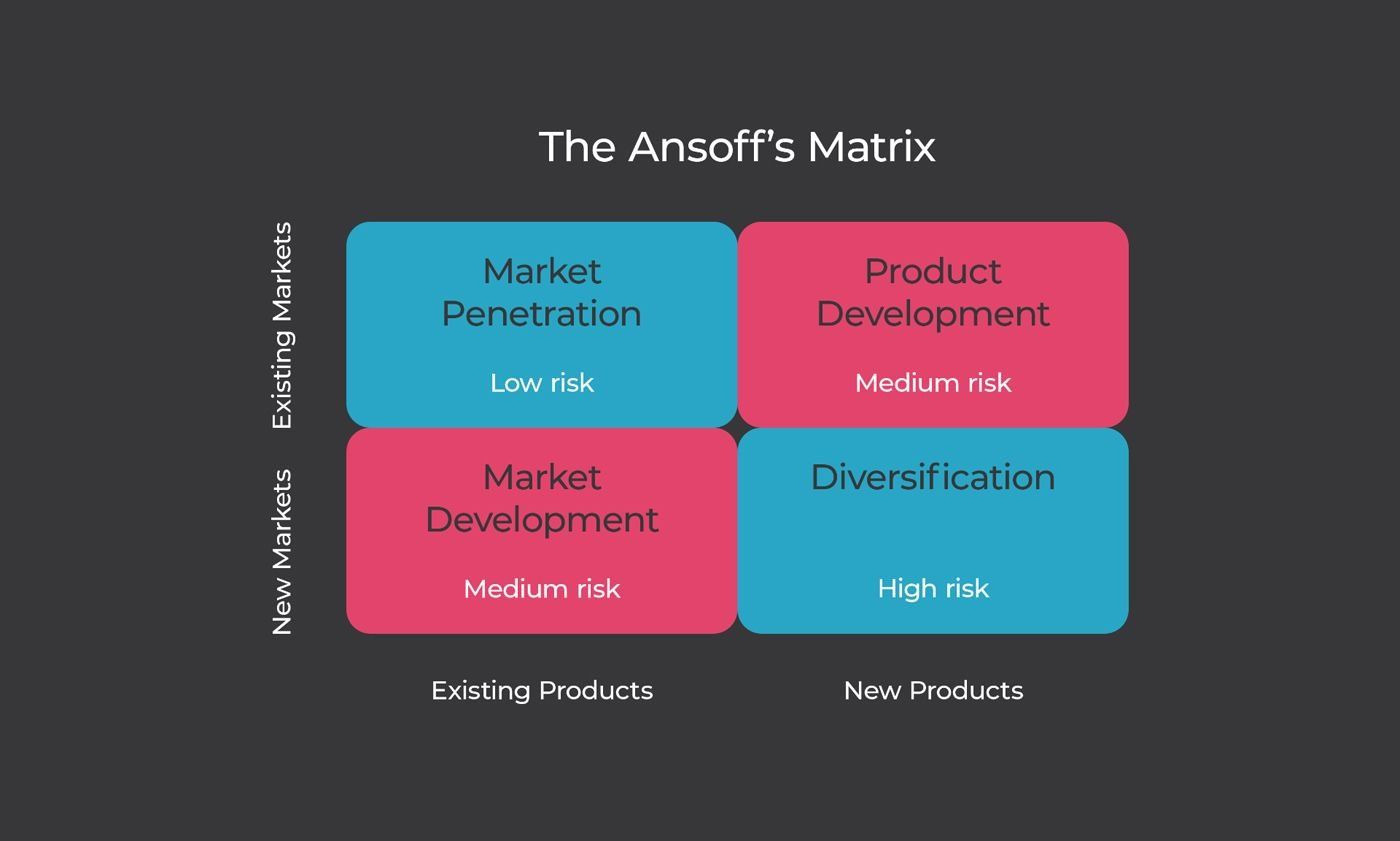When entering markets and developing new products, manufacturers and retailers face the dilemma of allocating resources. They need to carefully plan every step in their product marketing strategy to avoid risks of failure and high costs. Without a plan, it is easy to end up making wrong decisions and miss business opportunities. That’s why most business owners use the Ansoff Matrix for successful marketing planning.
Ansoff Matrix Grid helps analyze product launch and market expansion risks and offers four growth opportunities. A far-sighted brand marketer turns to the Matrix when developing their marketing strategy and uses one or two tactics tailored to their individual case. This way, the company can reach new customers, expand the business and stay ahead of the competition.
Ansoff Matrix or Product/Market Expansion Grid was developed by Igor Ansoff and published in the Harvard Business Review in 1957. It covers marketing strategies for product and market development. The Matrix can be visualized as a grid of 4 and more quadrants that outline possible business growth scenarios that vary in risk.
The marketing department of our 3D rendering company has been exploring the topic in terms of furniture business and eCommerce. In this article, we talk about what Ansoff Matrix is and what types of promo materials one needs for each of the listed strategies. So here they are, the 4 key marketing strategies, according to Ansoff.
1. Market Penetration
existing product — existing market

This product marketing strategy is aimed at increasing demand for goods that are already well-known to the audience. To draw more attention to a product, furniture manufacturers, for example, can improve its quality, revamp business processes, get on new eCommerce platforms and invest in advertising. They pursue the following marketing goals:
- increasing the customer base
- adding new marketing channels
- boosting advertising in existing channels
- improving customer lifetime value
- upselling goods
- introducing customer loyalty programs
- reducing churn
Like any other strategy, Market Penetration has its own advantages and risks, so let’s take a closer look at those:
Benefits
- Since marketers know all key product indicators such as conversion, average check, churn, it’s easier for them to build a business plan for growth.
- Retaining existing markets is usually less expensive than entering new ones.
Risks
- A product can become outdated. If it happens buyers quickly switch to more relevant goods offered by competitors.
- This strategy is more focused on retaining existing audiences but not on market or product growth.
For an effective Market Penetration planning tactic, furniture brands might need different types of images and first-class product videos. Surely, organizing actual photo- and video shoots is an expensive endeavor, hence, many brands opt for 3D renders and animation.
2. Product Development
new product — existing market

This product marketing strategy is based on introducing new goods or improving existing ones for the current market. When it comes to the furniture industry, manufacturers can upgrade the design of a piece, choose another color scheme, or produce the same item made of eco-friendly materials.
Brand’s key goals with this strategy are:
- Finding the best selling version of the product in case of launching several options. When introducing only one furniture piece, a brand should keep modifying its design until it’s successful.
- Launch a product on the market as soon as possible.
Benefits
- Marketers perfectly know the market they work with. They have a base of loyal clients whom they can engage in customer surveys and test all design options before manufacturing the piece.
- All promo and marketing tools are well-known and time-tested.
Risks
- A customer’s reaction to a new product is unpredictable. The goods may not sell as expected or even fail.
With new products to promote, brand marketers have to renew their marketing and promo campaigns. One of the best options here is to use product lifestyle images that showcase a furniture piece in a suitable environment. Using CGI, marketers can forget about organizing actual photo shoots — they can get ready CG product visualization in a few days! Such lifestyles work perfectly for a cross-selling technique that is based on showing a new product in one scene with the bestsellers. This way, a brand can motivate shoppers to purchase a set of items in one go.
3. Market Development
existing product — new market

Once a product takes a solid position on one market, manufacturers start looking for new audiences to sell it to. They can either enter a foreign market or try to target new local segments. Surely, there are certain risks in both cases so this product marketing strategy requires thoughtful research and outlining the brand’s goals. Those could be:
- Defining the most profitable market segment
- Positioning a product and create product messaging
First, marketers identify opportunities and threats of the new market, check existing demand, legal requirements, and so on. Only then can they introduce a product to customers. They can use online advertising and promo to draw the attention of potential buyers to their goods. While running digital marketing campaigns, specialists closely monitor statistics to understand if their offer is relevant and in demand.
Benefits
- Expanded target audience
- Increased revenue
- Brand growth
Risks
- The goods may not work with particular segments and markets;
- A new marketing strategy might affect the existing audience causing customers to stop buying a product.
Apart from pushing online ads, brands need to tailor catalogs and assembly instructions for a foreign market, update packaging and visuals for each specific promo campaign. For example, when entering the Middle Eastern or Chinese market, American brands should reconsider the visual representation of a product. Most often, this means that marketers need to use new lifestyle images and adapt all their visuals according to relevant market trends. Needless to say, achieving this with CGI is much faster and more effortless than redoing the whole photo shooting process.
4. Diversification
new product — new market

Diversification is one of the riskiest strategies for marketing a product and developing the market. Since both components in this equation are new, the whole campaign can be costly and unpredictable. Typically, a brand uses this product marketing strategy when it gets the most from existing markets and products. Also, marketers often opt for diversification if they have a potential bestseller and a well-thought-out plan. Depending on the case, there are two types of this marketing strategy to choose from.
Related Diversification
This tactic is best for launching a new product that is to some extent related to goods from a brand catalog. For example, when an upholstered furniture company decides to start producing cabinetry, it is not very risky in terms of both production and marketing.
Unrelated Diversification
This marketing strategy is for completely new goods that have nothing to do with the current ones. Let’s say, a furniture brand plans to start textiles manufacturing. In this case, they have to not only make a lot of changes to the manufacturing process but also find a new target audience and develop brand new marketing materials.
Benefits
- Increased market share
- Company growth
- A larger customer base
- Increased revenue
Risks
- Product development is expensive, as well as time- and effort consuming
- A product may fail or don’t sell as expected
- New market dynamics are unpredictable
Being one of the most widespread marketing instruments, the Ansoff Matrix requires an individual approach to every case in order to build a truly effective strategy. To get it right, first, marketers have to check if the product marketing strategy meets the brand’s goals they set for this particular period. Secondly, they need to go through all available resources to find the best tools for campaigns. Also, they can conduct a survey of the company’s experts using the SFA Matrix. With homework done, they can make the right decision.
To gain more insights into the world of digital marketing, check out our article about the RACE marketing model.
Whether companies introduce a new product or enter new markets, they need lots of product imagery for catalogs, advertising, marketing and promo campaigns. With 3D modeling and rendering at hand, marketers can get visuals for pre-launch promo and customer surveys without excessive prototyping. Moreover, they get photorealistic product images and motion solutions for marketing campaigns with no actual photo- and video shoots involved.
Need top-notch imagery for your product marketing strategy? Reach out to us for 3D modeling services , and get plenty of visual materials that suit all your marketing goals!
